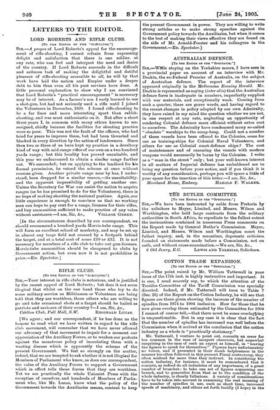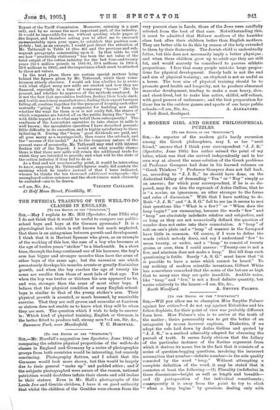[To THE EDITOR Ow THE"SPECTATOR. ' ] SIR,—The point raised by Mr.
William Tattersall in your issue of the 17th inst. is highly instructive and important. It is one, I need scarcely say, to which the attention of the Textiles Committee of the Tariff Commission was specially directed. Indeed, if Mr. Tattersall will turn to Table 7 (Sec. 26) of the Report on the Cotton Industry, he will see that figures are there given showing the increase of the number of spindles from 1874 to 1904 inclusive. How far those that he now gives overlap those estimated by the Committee for 1904
I cannot of course tell,—that there must be some overlaPpini is unquestionable. But in any case it is clear that the' fact that the number of spindles has increased was well before the Commission when it arrived at the conclusion that the cotton industry as a whole is " practically stationary."
Mr. Tattersall, I venture to point out, commits an error far too common in the case of inexpert observers, but somewhat surprising in the case of such an expert as himself, in " leaving the figures to speak for themselves." Figures have unfortunately no voices, and if presented in their dumb helplessness in the manner too often followed in this present Fiscal controversy, they often mislead far more than they instruct. In considering the cotton industry, for instance, it must be remembered that it consists, as indeed do all industries of any importance, of a great number of branches : to take one set of figures concerning one branch, and to generalise from that as' to the condition of the whole industry, is clearly fallacious. A variety of considerations have to be taken into account in examining the real meaning of the number of spindles in use, such as short time, increased speeds of machinery, and others set forth lucidly (I hope) in the Report of the Tariff Commission. Moreover, spinning is a part, only, and by no means the most important part, of the industry. It would be impossible for me, without quoting whole pages of .the Report, and therefore asking you to allow me to encroach :unwarrantably upon your space, to establish this position com- pletely ; but, as an example, I would just direct the attention of Mr. Tattersall to Table 14 (Sec. 40) and the previous and sub- sequent paragraphs commenting upon it. In that table he will see how "practically stationary" has been the net value of the total output of the cotton industry for the last four-and-twenty years (51•4 million pounds in 1881-85, 53.4 millions in 1901-4, .531 zillions in 1904), and the importance which must be attached to those net values.
In the next place, there are certain special matters lying behind the figures given by Mr. Tattersall, which their voice- lessness utterly obscures. I would ask him whether he is aware y with what object many new mills are erected and, how they are: financed, especially in a time of temporary " booms " like the present, and whether ho approves of the methods employed. Is it not the fact that speculative builders, finding their trade slack, and textile machinery manufacturers, finding their export business falling off, combine together for the purpose of keeping each other mutually "going," to form companies for building new mills whether the want for them is or is not really felt, the shares of which companies are foisted off on the public during the " boom " with little regard as to what may befall them subsequently? The readiness of the Lancashire operative to take shares in mills is well known : the speculative operation I have described presents _little difficulty in its execution, and is highly satisfactory to those initiating it. During the " boom " good dividends are paid, and all goes merry as a marriage-bell ; then conies the set-back, and the "reverse of the medal." As to the temporary nature of the present wave of prosperity, Mr. Tattersall may read with interest Section 119 of the Report. I would ask what possible chance there is that these new mills will retain the additional trade for which they are intended to provide, and what will be the state of the cotton industry if they fail to do so. As a final and not unnoteworthy point, it would be interesting to know, supposing Mr. Tattersall's figures really did contain the meaning which he implies instead of that I have indicated, whence he thinks the ten thousand additional workpeople—tho unemployed cotton-spinners and the short-timers must obviously be excluded—are to be drawn.
42 Half Moon Street, Piccally, W.



















































 Previous page
Previous page